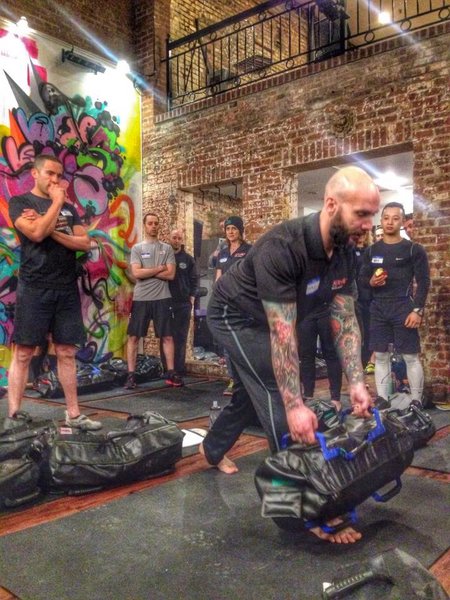Is Your Training Really Functional?
By Josh Henkin, Master RKC, Creator of the DVRT System

For the past seven years, I’ve started almost every one of our
Dynamic Variable Resistance Training (DVRT™) programs with one simple question that really gets some interesting responses—which says A LOT about the fitness industry.
"What does functional training mean?"
This yields many different responses: "Training for the real word." "Training the whole body." "Training movement."
While there are always many responses, and shows that the fitness industry doesn't really have a universal definition of "functional training". How is that possible? Why haven’t we defined a term that’s been in the industry for at least 20 years? We have textbook definitions for maximal strength, muscular endurance, and most aspects of fitness.
But, who cares? What’s the real reason I ask, "What does functional training mean?" I always ask because it sets us up for a much more important question, "How do we use functional training in our workouts and programs?" So much "stuff" has been labeled as "functional" in the fitness industry that it can be REALLY hard to figure out what is actually beneficial and useful in our mission of improving the efficiency of human movement. Improving the efficiency of human movement is the
DVRT definition of functional training.
Understanding this idea is SO important, because in reality most of our "functional training programs" aren’t very functional! They leave out HUGE aspects of movement and if some aspects are taught, the progressions and full scope of these movements are still rather limited. One of the easiest ways to spot a program and/or coach with an understanding of functional training is if they teach a system of rotational-based training.
Why would I choose that specific aspect? Why is rotational training so important in our functional training programs? Because punching, throwing, kicking, and many power-based movements have a HUGE rotational component. Our bodies are actually designed to create more power by using rotation through the various chains in the body.

For example, pick up a ball or something to throw. Try throwing it by only leaning back through your trunk and whipping with your arm. What did you notice? You probably felt like your arm was going to pop off and the throw was less than impressive. Now, grab the ball, pivot hard through the ground, and use your body to create a powerful rotational movement. I hope you can feel the difference—greater power, less stress in the arm, and the feeling that the movement really begins at the ground.
A National Geographic Channel show called Fight Science examined all sorts of combative sports and found that the success of the movement universally comes from this strong pivoting action. If we can become stronger and more powerful, then why don’t we teach more rotational training?!
I think there are a few different reasons, some of the good reasons include not knowing proper progressions or concern about people using their backs instead of their hips. An invalid excuse is given when someone doesn’t want to do exercises which require lighter weights!
Before I tell you how to build very successful rotational training into your programs, let’s address a few mistakes that MANY people make when trying to use this method.
Mistake #1: Moving through the low back:
You might think we only see this with old-time exercises like Russian twists, but I can’t even count how many people use their low back INSTEAD of their hips for simple medicine ball drills. Isn’t rotational training about rotating the torso?
Many of us were taught this early on, even though rotational movements truly occur through the hips, not the low back. In fact, our lumbar spine has minimal movement—and it sits right above the VERY mobile ball and socket hip joints!
This pivoting action helps us create strong and powerful rotational movements. So, if you are have felt like you’ve demolished or stiffened your low back after some "rotational training", I bet you made this very mistake!
Mistake #2: Bad hip mobility
One of the big reasons people move through their low backs is they don’t possess internal hip rotation—the ability to turn their hips inward. The truth is most people have bad internal hip rotation, either from bad training programs, sitting most of the day, or from an injury.
Possessing good hip internal rotation can save your low back. Numerous studies point to a strong correlation to low back pain and the inability to internally rotate the hip.
We need the ability to move well in our hips before we start adding load or trying to be powerful. So, how do you know if you have good internal hip rotation? Here is a simple self-test you can try:
Sit in a 90-90 position. If you can’t sit upright very comfortably, chances are you have a problem with internal hip rotation. Make sure to check both sides as many people have an imbalance from side to side—which is actually a BIGGER issue leading to pain and dysfunction!
Watch the video below for some drills and a workout to help build internal hip rotation:
Mistake #3: Trying to be really powerful
I have never understood why people don’t build up to any rotational training when we are supposed to be super powerful in rotational exercises like throwing medicine balls. Rotation, like all of our other human motions, should be built up from a foundation of strength before working on power. This means working on rotation in different loading angles and adding small layers of complexity to the movements.
Check out some of our DVRT rotational sequences to see how you can progressively build to stronger and more powerful rotational movements!
I really hope that you are thinking about all the different ways that you don’t move in your training. While some people may feel frustrated that this type of training doesn’t come easy, I actually think it is exciting! It means you haven’t even come CLOSE to reaching your movement potential!
Try these progressions, but more importantly become GOOD at them! Then you will see how much better you can really live and perform
Back